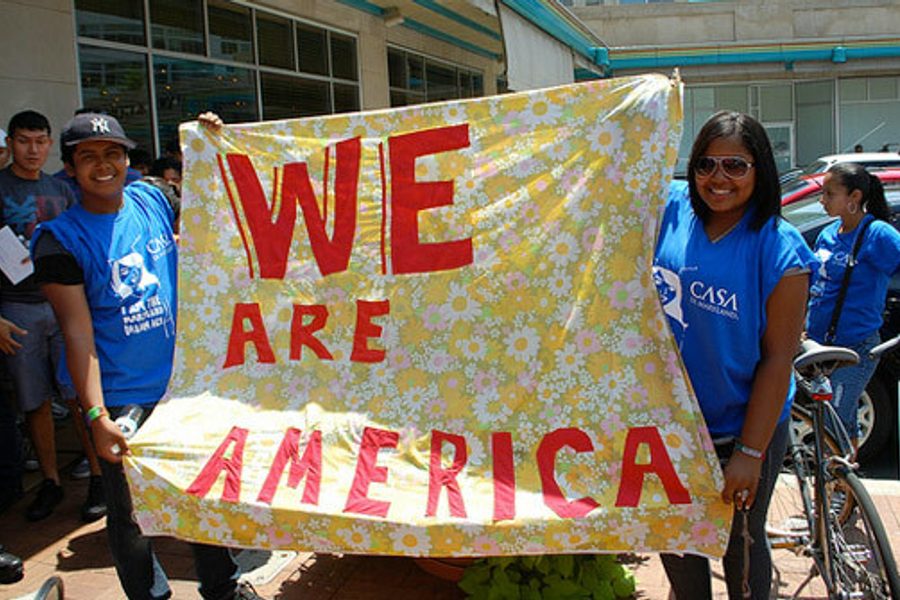
This week the White House rolled out its “Deferred Action” policy, cracking open the door to legal status for hundreds of thousands of young immigrants without papers. Many see the promise of temporary protection from deportation as a first step toward genuine immigration reform. But the future is unclear: What exactly in it for these these youth, when all they’re being offered is temporary protection?
The Obama administration’s new policy, aimed at pleasing the Latino electorate, initially set off a flurry of celebration among immigrant youth activists who had long pushed for the DREAM Act. But skepticism persists. Legal protection derived from a directive from the Department of Homeland Security is, by nature, tenuous. The fate of the program could depend on who is in the White House next year. And unlike the DREAM Act, the Deferred Action policy allows people to work and study, but does not offer a direct path to long-term legalization.
On the other hand, Deferred Action offers some youth at least a modicum of security and could galvanize the broader movement to resist dysfunctional immigration policies.
Essentially, youth who came to the United States as children are now eligible for a two-year, renewable stay and a work permit, if they meet various criteria, including: being 30 or younger, possessing a clean criminal record and having arrived before age 16.
The New York Times described the anxious scene at a public gathering in Chicago where thousands gathered to ask about their legal options:
Maria Rodriguez, 19, who attends a community college in the Chicago suburbs, said she had been waiting since 1 a.m. in a line that eventually stretched the length of the pier. …
“Finally, I can help pay for my school,” she said. “All my education is going to pay off now. I can actually get a job.”
But that optimism may fade in the face of the bleak landscape that most young job seekers face today. Twenty-somethings are burdened by crippling student debt, an anemic labor market and social policies that thwart upward mobility for the poor, people of color and women. In this climate, gaining work authorization won’t mean immediate economic advancement for young immigrants; it won’t mean a living wage or a fair chance at an affordable college education; and it won’t really narrow deep income disparities.
Those obstacles may impose hurdles to even joining the program, says Angy Rivera, an undocumented activist with the New York State Youth Leadership Council. She notes that many underpaid or unemployed immigrant youth, already burdened by the general economic crisis, will “struggle to afford the basic application fees.”
Ironically, baseless fears of immigrants “stealing” the jobs of “real Americans” has distorted the entire debate about immigrant youth in the labor force. In reality, immigration tends to boost the economy overall. Besides, unemployment is a structural problem; it’s not about Malthusian competition so much as creating a more inclusive, humane economic system for all. That’s why, rather than simply deferring uncertainty, the White House’s ultimate goal should be to permanently end young immigrants’ legal limbo and give them a chance to live with dignity in the country where they’ve planted roots.
Adding to the financial costs of temporary, lopsided reprieve are the logistical burdens and legal risks. Some youth could inadvertently make themselves more legally vulnerable just by coming forward as undocumented. DHS vaguely claims that application information will not be shared with immigration enforcement agents. But the administration’s general approach to enforcement suggests that even a minor run-in with the authorities or a blemished record could expose an undocumented immigrant to arbitrary detention or deportation proceedings.
Immigrant Youth Justice League warns that the Obama administration’s earlier promise of “prosecutorial discretion” – granting clemency in “low-priority” deportation cases of people who aren’t deemed a security threat – has reportedly aided only an outrageously tiny fraction of those who should be eligible for relief.
Domenic Powell, an activist with the National Immigrant Youth Alliance, notes that many undocumented workers already try to pay their share in taxes by using Individual Taxpayer Identification Numbers. The new employment authorization that Deferred Action enrollees will receive, Powell argues, “does take an additional step toward the auspices of legality, but it’s still an expression of the federal government’s belief that someone’s labor can be legal while the person is not.”
The Obama administration made a careful political calculation when it offered Deferred Action. Now it’s time for DREAMers to cautiously weigh their fears against their dreams. Temporary relief from deportation could open the door to more exploitation of young immigrants, but it could also further embolden them to agitate in public for economic justice and human rights, and to defend communities against policies that have for years crushed so much human potential. In the coming months, we’ll see what becomes of a dream deferred.
Michelle Chen is a contributing writer at In These Times and The Nation, a contributing editor at Dissent and a co-producer of the “Belabored” podcast. She studies history at the CUNY Graduate Center. She tweets at @meeshellchen.








